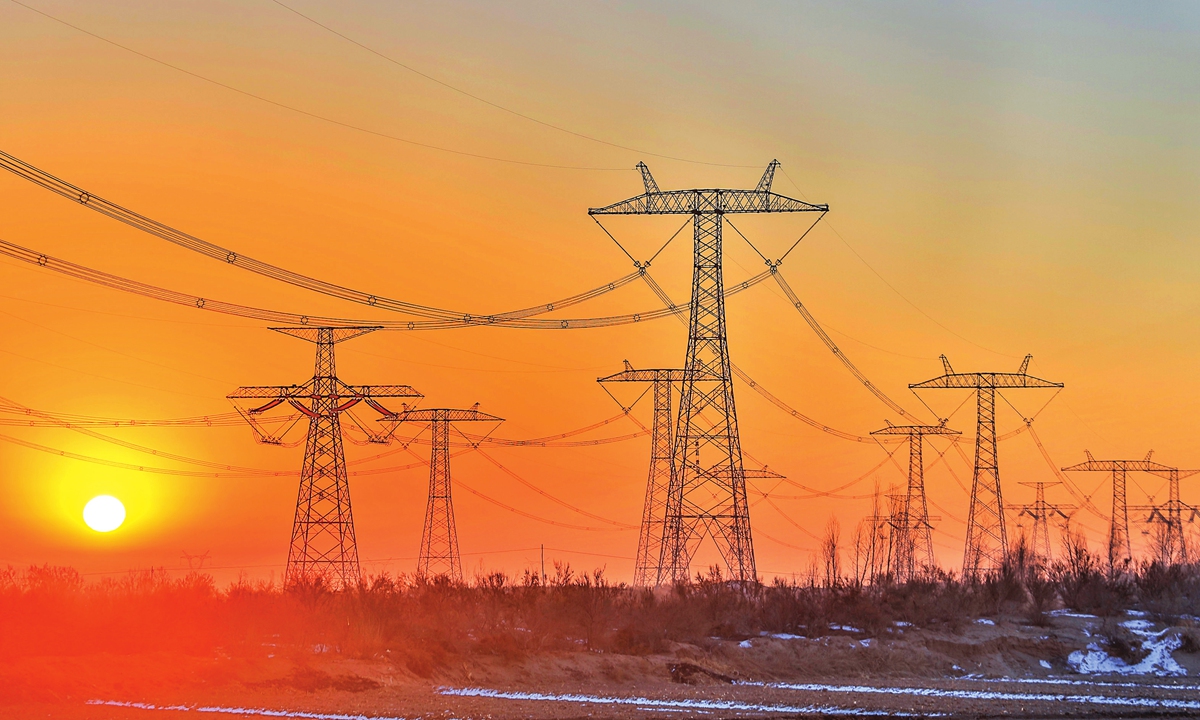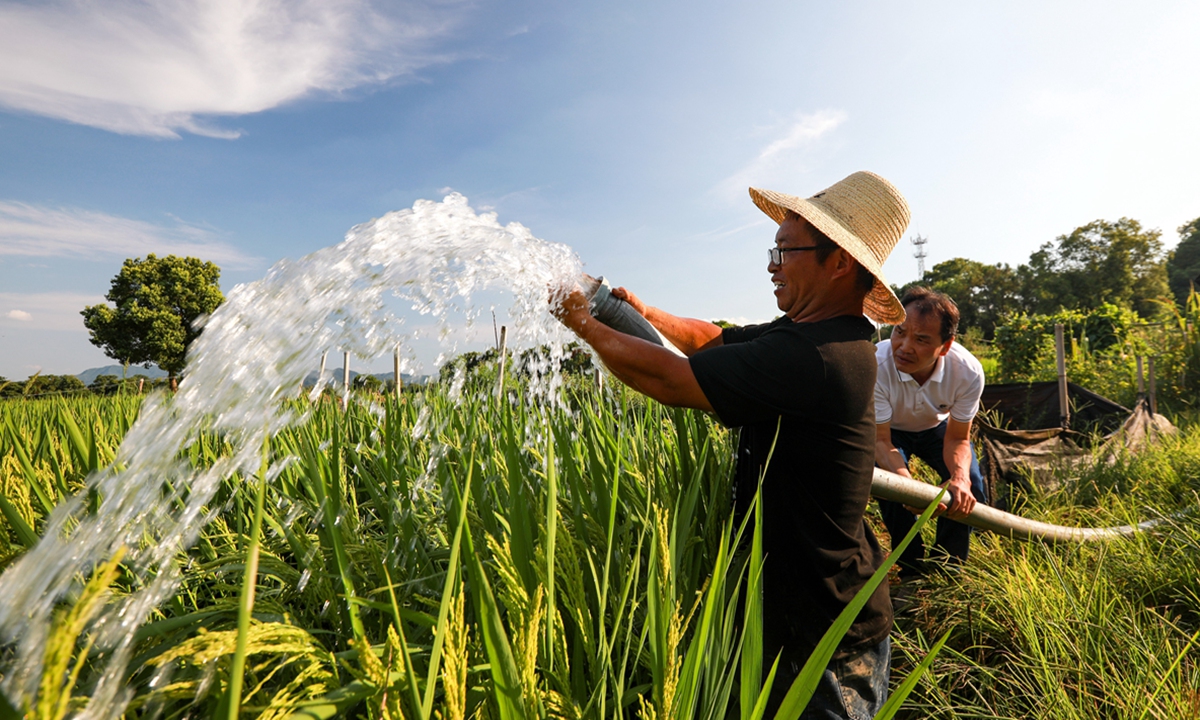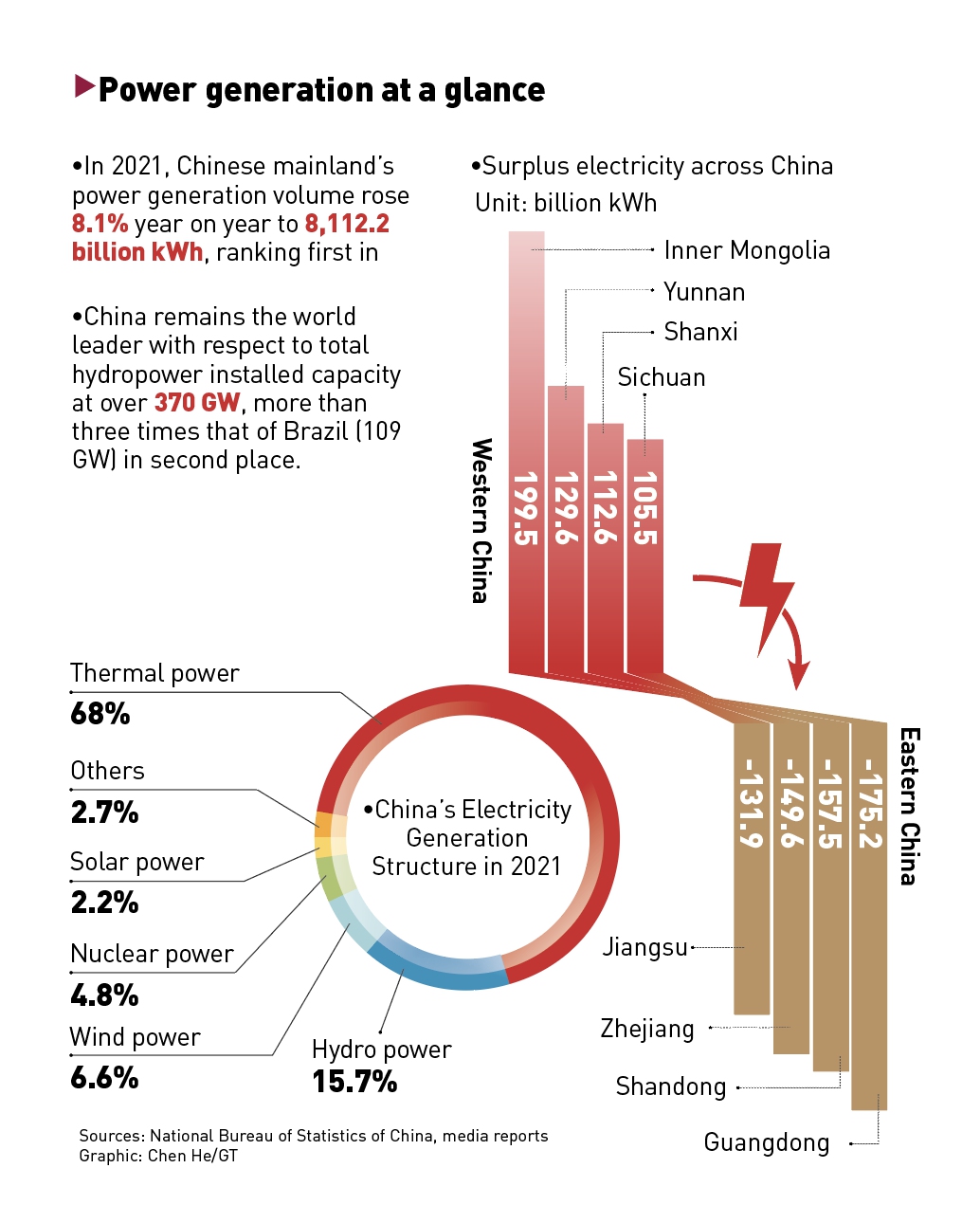IN-DEPTH / IN-DEPTH
China’s power supply, energy structure tested in extreme drought amid transition to cleaner energy future
Galvanizing energy tests

Sunrise over the ultra-high voltage lines of the west-to-east electricity transmission project in Wuwei, Gansu Province, on January 1, 2022. Photo: IC
As the rare triple-dip La Nina treks the globe leaving behind it extreme weather phenomena and disasters, some regions in southern China are experiencing a severe drought that only happens once in decades, which has challenged the country's power supply and storage system.Southwest China's Sichuan Province, which largely relies on hydropower, has been facing the severest difficulties in history in ensuring power supply in recent weeks due a triad of challenges of extreme high temperatures, record low precipitation, and high power demands in the same period.
Moreover, by mid-August, about 12.32 million mu (821,333 hectares) of arable land had been hit by the drought along the Yangtze River, prompting the Ministry of Water Resources' urgent deployment of resources to ensure irrigation.
China has a robust system of power generation, transmission, and storage, as well as well-developed water irrigation infrastructures through constructing different water conservancy projects according to the resources and geographical conditions of diverse regions. It is also leading the world in developing new energies.
But shortcomings also exposed in what is happening under such rare and extreme conditions have alarmed people who are used to modern life powered by large volumes of electricity and water.
In the process of building a new power system, the task of ensuring power supply is always the bottom line. However, with the increase in abnormal weather phenomena, power supply may suffer greater risks, analysts noted.
Nationwide electricity distribution

The Jialing River shows part of its riverbed at the Chongqing section due to severe drought on August 17, 2022. Photo: VCG
How the country is able to meet the huge amount of electricity consumption has been an issue of concern, especially amid efforts to promote green and low-carbon energy transformation.In 2021, China's power generation volume rose 8.1 percent year on year to 8,112.2 billion kWh, ranking first in the world, according to the National Bureau of Statistics (NBS) of China. Statistics from 2021 also show that China's coal-powered electricity generation accounted for 68 percent of the country's total power generation, while hydropower covered 15.7 percent.
Nationally, South China's Guangdong Province is the largest power generator in China, with an annual generation of 611.5 billion kWh, mainly relying on coal and nuclear power.
However, Guangdong still has the biggest electricity shortage among all provincial regions in China because of its large-scale industrial production and large population. Eastern provinces such as Shandong and Jiangsu face a similar situation.
Therefore, northern Chinese regions, such as Inner Mongolia, Shanxi, Xinjiang and Ningxia, and southwestern provinces like Sichuan and Yunnan exported the most surplus power to more populous and developed eastern regions, forming China's "west-to-east" power supply grid.
Along the coast, from Northeast China's Liaoning to South China's Hainan, 54 nuclear power units were in operation as of July 2022, the second-largest number in the world following the US, the Global Times learned from the Ministry of Ecology and Environment.
China's power generation has demonstrated resilience, given efficient government mobilization capacity nationwide, stable coal supply, and massive renewable energy infrastructure projects.
During the current power supply crisis, the State Grid Corporation of China (State Grid) has maximally mobilized power resource from across other provinces to Sichuan. Moreover, the Three Gorges Dam increased water discharge to help ease a severe drought in the middle reaches of the Yangtze River since August 16.
Undeniably, China's current power system as a whole has developed to be the world's leading model with the most advanced, digitalized and automated infrastructures that widely cover various regions, analysts said.
Lin Boqiang, director of the China Center for Energy Economics Research at Xiamen University, told the Global Times on Monday that "China has the advantage of being a big country, as when a region is facing challenges, other parts can assist," he noted.
Coordinated water supply for irrigation

Village officials and villagers irrigate farmland with water from a drought-resistant well in Yincun village in Ji'an, Jiangxi Province, on August 15, 2022. Photo: VC
Resources, since July, most parts of the Yangtze River Basin have experienced high temperatures and low precipitation, with rainfall 45 percent lower than the same period in previous years.The water storage of reservoirs in some provinces along the Yangtze River, including Sichuan, is at least 10 percent less than previous years. The drought-hit region is also China's traditional agricultural region, which is at a critical juncture for autumn grain harvest.
China's Ministry of Agriculture and Rural Affairs has urged regions with adequate irrigation facilities to coordinate water supply distribution, while the farmers are being guided to implement a series of measures, including deep water cooling, to dissipate heat in accordance with local high temperature and drought conditions.
As a response, at present, for instance, there are 4,939 reservoirs in Hubei currently participating in irrigation and drought relief, providing about 92 million cubic meters of water daily.
Analyst pointed out that the high temperatures compounded by drought are the major factor behind the shortage of electricity in the southern provinces which have a high proportion of hydroelectric generation. Those provinces traditionally relied on hydroelectricity to supply peak summer electricity consumption.
By the end of 2021, the installed hydropower capacity in Sichuan had reached 88.87 million kW, accounting for 77.7 percent of the province's capacity; the installed capacity of thermal power and wind power only accounted for 16 percent and 4.6 percent respectively.
As Sichuan experienced unexpected high temperatures, the highest in 60 years, and the precipitation upstream having decreased significantly compared with previous years, the hydroelectricity storage capacity has become seriously insufficient. Meanwhile, the transportation capacity of coal from other provinces into Sichuan is also insufficient. As a result, Sichuan is facing the most difficult summer supply season, according to analysts.
By the end of 2021, the installed hydropower capacity in Sichuan had reached 88.87 million kW, accounting for 77.7 percent of the province's capacity; the installed capacity of thermal power and wind power only accounted for 16 percent and 4.6 percent respectively.
As Sichuan experienced unexpected high temperatures, the highest in 60 years, and the precipitation upstream having decreased significantly compared with previous years, the hydroelectricity storage capacity has become seriously insufficient. Meanwhile, the transportation capacity of coal from other provinces into Sichuan is also insufficient.
An expert who preferred to remain anonymous told the Global Times that China has built an advanced power supply system which can meet consumption demands most of the time, but in the face of extreme weather conditions, it is still hard to meet the demand.
Meanwhile, the current wave of developing renewables has become a temporary challenge to ensure the balance of supply and demand of electricity in real time, especially during peak electricity consumption, experts said. Hydropower is not yet able to withstand the effects of extreme weather, and new energy sources are far from enough to cope with extreme weather.
People's livelihoods guaranteed
Currently, energy shortages caused by extreme weather have become a common problem worldwide. However, while the US and Western media have targeted several parts of China's restrictions on electricity consumption due to strained supply, their own countries are facing fragile energy situation and subsequent public outcry.
At present, extreme weather and a shortage of natural gas have plunged Europe into a new severe crisis - with soaring demand for electricity and limited generation capacity causing record-breaking power shortages.
Bloomberg analyzed that with regard to energy supply, European countries are struggling to secure power-generating capacity.
France, for example, used to be a power exporter, with its atomic output accounting for 69 percent of the country's total electric-ity production. But Bloomberg Opinion columnist Javier Blas revealed in a podcast interview that about 50 percent of the country's nuclear reactors are not operational at the moment, the output of which is set to fall to its lowest level in more than three decades this year and will not fully recover well into 2023, Bloomberg reported.
In Germany, as high temperatures have lowered river levels, coal, which is available, cannot be delivered to power stations along the Rhine in time. Worse still, due to Russia's slashing of gas supply during the Ukraine conflict, the German power grid may even be overloaded and collapse this winter.
Faced with such a grim prospect, analysts have pointed out that European countries will be more concerned with individual winter insulation rather than taking care of each other. "It could lead countries to turn against each other in terms of whether energy is allowed to flow across borders," Jason Bordoff, a former adviser to Barack Obama told the New York Times.
While in the US, there are still many people who remember the chaos caused by the Texas blackout that ensued in winter 2021. With an outdated power grid, a loose confederation of rogue private power producers, and a fractured political system unable to effectively respond to emerging crises, more than 4 million people in the oil-rich state of Texas were left without electricity when a cold snap hit the country.
Experts pointed out that as opposed to the Western countrie, China is fully capable of coping with the current temporary power supply crunch and always has its bottom lines on water and electricity supply in sight. "The first line is that the country does not ration electricity, which means once electricity shortages occur, the country should be able to use all means available to guarantee supply, whether from coal-powered sources or others."
"People's livelihoods must be guaranteed," Lin said.
At the same time, the Chinese government is committed to safeguarding the bottom line in people's drinking water safety, especially in rural areas, doing its best to ensure availability of seasonal irrigation water for crops, according to the Ministry of Water Resources.
However, the rare high temperatures and drought this year are an alarm bell to us that the world should pay more attention to climate change.
According to Lin, China should build up pre-warning systems against extreme weather phenomena and invest in a more stable power grid and more scientific reservoir joint dispatch mechanisms. The public would certainly show more support to the development of new energy.

Graphic:GT



